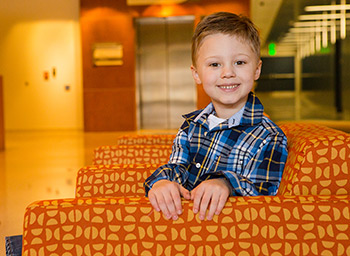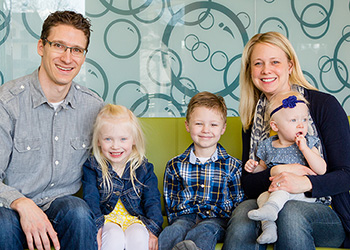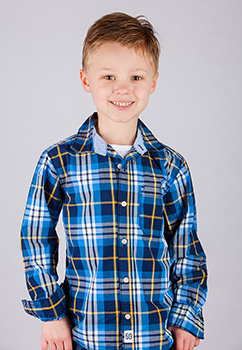Miracle Kid: Craig Winter
Pittsford Youth Fights on Against Cancer Diagnosis
 Kim Winter picked up the phone. It was a call she’d been waiting for all afternoon.
Kim Winter picked up the phone. It was a call she’d been waiting for all afternoon.
“…I see… No, I just knew it. I knew something wasn’t right…”
A few hours earlier, she’d waited on the ground floor of Golisano Children’s Hospital while her 5-year-old son, Craig, had his brain and spinal cord scanned in the hospital’s new MRI.
Craig had smiled when he’d seen the machine for the first time. It was built to look like a pirate ship — “S.S. Rochester” is etched on its hull.
But now the scan had come back. The news wasn’t good. As Kim hung up the phone, images began flashing through her mind. Craig, nauseous from round after round of chemotherapy. Craig, too weak to spend more than a few minutes outside. Craig, enduring biopsies, blood tests, and the rest. But for Kim, these weren’t abstractions. She wasn’t imagining her son’s future. She was remembering his past.
‘They Couldn’t Believe He Could Walk’
For the parents that have endured it, a child’s cancer diagnosis is life’s most devastating news.
The only thing that’s harder is if they’ve had the conversation before.
“Because they already know what they’re in for,” said David Korones, M.D., Craig’s oncologist at Golisano Children’s Hospital.
When the scan last October showed that Craig’s tumors were growing again, three years had passed since his initial diagnosis.
Prior to that, he was a normal, energetic 2-year-old. “He just bounced off the walls,” said Kim Winter.
But one day, he began complaining of a headache. Then another. Then he was waking up at night, screaming about how much his head hurt.
His pediatrician referred him to Howard Silberstein, M.D., staff neurosurgeon at Golisano Children’s Hospital. A brain scan revealed a cyst — which Silberstein drained — but no tumors. Still, when Craig’s headaches returned a short time later, Silberstein knew something wasn’t quite right. So he ordered one more scan — this time an MRI of Craig’s spine.
It was a scan that his doctors had never seen before.
 “Within minutes we had teams of people in his room. He had more spinal tumors than they’d ever seen in a 2-year-old,” said Kim Winter. “They couldn’t believe that he could even walk.”
“Within minutes we had teams of people in his room. He had more spinal tumors than they’d ever seen in a 2-year-old,” said Kim Winter. “They couldn’t believe that he could even walk.”
Soon after, Kim and her husband, Tim, had their first conversation with Korones. "He said that just because it was very rare doesn’t mean it’s not beatable,” said Tim Winter.
Craig had a disseminated glioneuronal tumor, meaning it had and spread throughout his brain and spinal cord. It was slow-growing, and Korones thought it could be managed, but it was so rare that there wasn’t an established treatment.
“This wasn’t something you could just look up in the books,” said Korones. “What I did was contact several colleagues from around the country to work out a plan.
”Surgery wasn’t an option – the tumors were too widespread, and removing them would affect too much of Craig’s brain and spine. And Craig was far too young for radiation.
That left chemotherapy.
For a while, it was working. The tumors were shrinking. But after three months, Craig developed an allergic reaction, which forced the end of the first round of treatment.
“It was really doing a number on Craig. His energy levels – he just wasn’t the same kid,” said Kim. “But it did significant damage to the tumors, so we were devastated when that treatment wasn’t an option any more.”
They transferred Craig to a different type of chemotherapy. This one wasn’t as effective as the first round, but it did prevent the tumors from growing. For Korones, that was good enough.
“It was always unlikely that chemo was going to cure him,” said Korones. “Really, the best treatment, the best shot at curing him is radiation. So the strategy is to get him as old as we can, so that when he undergoes radiation treatment, he has fewer long-term side effects.”
After about a year, the tumors started growing again. So Craig moved to a third type of chemotherapy treatment in early 2014. This therapy was the hardest on him.
“We pushed him through it, but it was very harsh on his body,” said Kim. “He was having these headaches that almost seemed like he was having a stroke. There were times where he couldn’t even communicate.”
But all the pain would pay off. Craig came off chemotherapy in December 2014, and for the next nine months, his tumors were stable. He attended the opening of the new Golisano Children’s Hospital, where his mother spoke to the gathered crowd about her son’s care. Soon after, he began attending kindergarten. Meanwhile, Kim, who had been staying home to care for her son, got a teaching job and went back to work.
Then came the scan last October.
“It was like having post-traumatic stress,” said Kim. “We just lived through that. And now we have to do it again?”
 The ‘Invisible Cancer’ Kid
The ‘Invisible Cancer’ Kid
When a child is cured of cancer, it’s rightly called a miracle. This variety of miracle may be in Craig’s future. But while his story isn’t over yet, the life he’s able to enjoy every day is a miracle to both his family and his physician.
After the scan last October, Craig started a fourth round of chemotherapy. It’s still early, but so far, Craig has responded well. His tumors have again stopped growing and the medication is easier on his body than previous rounds.
“I think this is the first year he really enjoyed sledding,” said Tim. “Before, he couldn’t be outside for more than a few minutes – he’d just be wiped. But his spirit and the way he accepts things are incredible.”
Korones agrees.
“Craig has such charisma, such pizzazz, and to maintain that sparkle and that joie de vivre despite everything he’s going through, to me, that’s a miracle,” he said.
He’s still a frequent visitor to Golisano Children’s Hospital. James Sanders, M.D., treats his scoliosis, which developed due to the tumor’s constant pressure on his spine. Robert Thompson-Stone, M.D., sees him for his headaches and the neurological side effects of his tumors.
And, of course, there are the biweekly chemotherapy treatments and quarterly MRIs. His parents are hoping that the treatment will keep his tumors at bay until age 10 or older, when radiation becomes a more appealing option.
It was four years ago that Craig was diagnosed, and it will be four more until his 10th birthday. His parents know that they’re all in it for the long haul.
But today, Craig is well. And he’s truly living.
“When we saw that scan when he was 2, I never imagined he would still be here,” said Kim. “I never thought he’d go to kindergarten. But now he’s truly that ‘invisible cancer’ kid. When you sit back and watch him, you don’t know what he’s gone through. It’s amazing.”